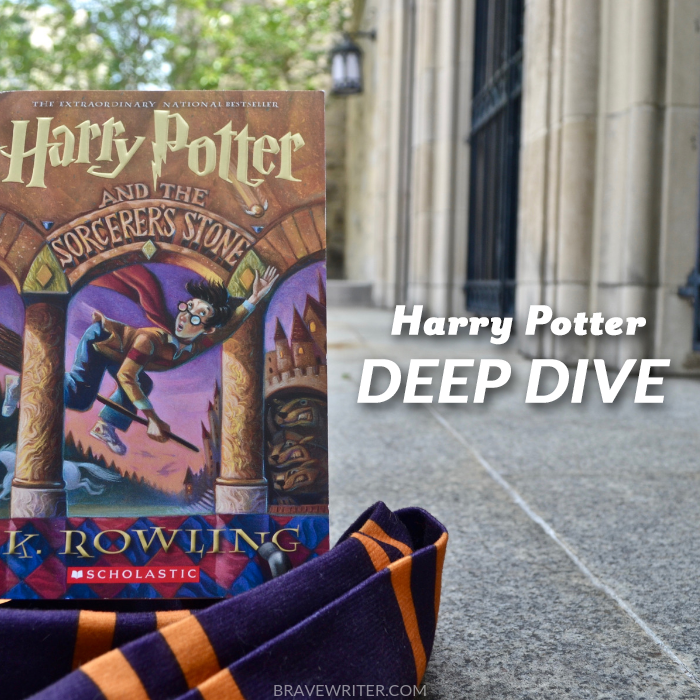DEEP DIVE with Us into the Magical World of Harry Potter!

Whether your kids are new to Harry Potter or veteran “Potterheads,” this delightful franchise primarily following the journey of the Boy Who Lived is not only enchanting to experience but is also a great opportunity to DEEP DIVE into literary techniques, adaptation theory, and even playwriting!
The Harry Potter universe is rich with diverse forms of storytelling and delves into universal themes such as love, loss, and the need to make a stand for what one believes in.
[This post contains Amazon affiliate links. When you click on those links to make purchases,
Brave Writer receives compensation at no extra cost to you. Thank you!]
The first installment of the Harry Potter novels by J.K. Rowling was published in the UK in 1997. As difficult as it may be to believe now, at the time Rowling was a complete unknown. A first-time author, she had written much of the first Harry Potter novel in a small flat while desperately trying to support herself and her young daughter. She had no idea that her little novel would explode into one of the biggest franchises of all time!
The Story
The Harry Potter series follows a boy wizard who, at its onset, does not know he is a wizard. An orphan raised by his abusive aunt and uncle, and tormented by his cousin, Harry believes there is nothing special about him at all, until one day a giant arrives and informs Harry that he is a wizard. Not only that but somehow, as a baby, Harry survived an attack from the greatest dark wizard of all time, Lord Voldemort. Harry’s parents died in the attack, but miraculously Harry survived with only a lightning bolt shaped scar on his forehead, and Voldemort’s powers were broken.
Harry leaves behind his miserable life with his aunt and uncle and begins magical training at Hogwarts School of Witchcraft and Wizardry. There he meets his best friends, Ron Weasley and Hermione Granger, and together they face mysterious plots, the impending return of Lord Voldemort, and perhaps most terrifying of all…end of year exams!
Diving In
The Harry Potter franchise now encompasses a book series, film adaptations, supplementary materials, a play, and now new films taking place long before Harry ever went to Hogwarts. It is one of the most successful and well-loved franchises and it provides a wealth of language rich experiences for kids and teens.
One of the wonderful things about Harry Potter is that you can decide how deeply you want to dive. If your child only wants to read the books, there is still so much to be learned, discussed, and examined. But if they want to read the books and watch the films, or if they want to take the full plunge into paratexts and prequels and plays, there is so, so much to be discovered.
Brave Writer Resources
Check out our Movie Wednesday posts for the first Harry Potter film as well as Fantastic Beasts and Where to Find Them. They include summaries and discussion questions, along with party ideas, recipes, and crafts.
Need even more discussion questions for Big Juicy Conversations?
Here are some more ideas to give your kids food for thought.
- Is Harry an unreliable narrator? The books are primarily from Harry’s point of view and present his thoughts and feelings as integrated parts of the narrative. Multiple times in the books, Harry makes assumptions about characters and their motives which are often proven wrong at the end, even though these assumptions are presented as fact at first. Should we ever completely trust Harry’s observations, then?
- A red herring is when a writer deliberately misleads the reader to come to an incorrect conclusion. Perhaps the most famous red herring in the Harry Potter series is Sirius Black in the Prisoner of Azkaban. Can you think of any other red herrings in the series? Which ones and did any of them fool you the first time?
- If you looked into the Mirror of Erised, what do you think you would see?
- The Goblet of Fire film is noticeably different from the book it adapts in order to conform to time constraints. When the movies were being made, there were quite a few fans who felt that the fourth book should have been adapted into two films instead of trying to cram the whole book (it’s over 700 pages long!) into a single film. Do you think the fourth Harry Potter film suffers from such heavy condensing or do you think the streamlined structure makes for a better film? Explain your answer.
A note to parents: Although the first three Harry Potter films are rated PG, many of the later films are rated PG-13 and contain some dark, mature, or frightening elements. We recommend looking up the films on sites such as Common Sense Media before deciding if they are right for your family.

















